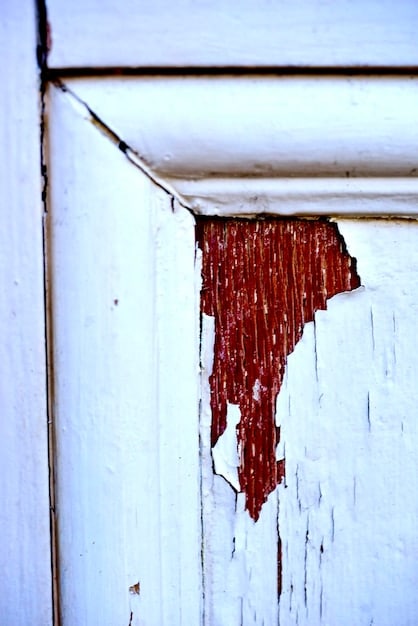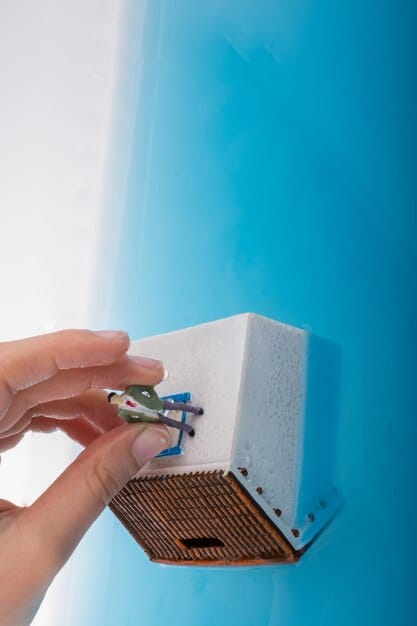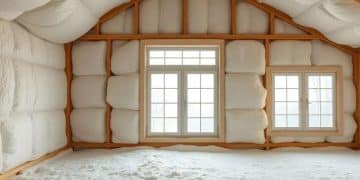Cut Energy Waste: Top 5 Overlooked Home Insulation Spots

Cut Your Energy Waste: 5 Overlooked Home Insulation Spots to Check Now focuses on identifying and sealing often-missed areas in your home where heat escapes or drafts enter, such as attic hatches, recessed lighting, wall outlets, ductwork, and basement rim joists, which can lead to significant energy savings.
Is your energy bill higher than you’d like? You might be losing heat or air conditioning through some sneaky spots around your house. Let’s Cut Your Energy Waste: 5 Overlooked Home Insulation Spots to Check Now, and discover how to keep your home comfortable and your wallet happy.
Unveiling Hidden Energy Leaks in Your Home
Most homeowners are aware that proper insulation in attics and walls is crucial for energy efficiency. However, many overlook the smaller, less obvious areas where significant energy loss can occur. Identifying and addressing these often-missed spots can dramatically improve your home’s energy performance, reduce your utility bills, and increase your comfort.
Let’s explore these hidden culprits and how to effectively insulate them to maximize your energy savings.

Attic Hatch: The Gateway for Heat Loss
The attic hatch, often a simple plywood panel, can be a major source of heat loss during the winter and heat gain during the summer. It’s frequently overlooked because it’s out of sight and out of mind. However, without proper insulation and sealing, the attic hatch acts as a direct pathway for air to escape.
Inspect Your Attic Hatch
Start by visually inspecting the hatch for any gaps or cracks around the edges. Feel for drafts on a cold day to confirm air leakage. Note the condition of any existing insulation on the hatch.
Effective Insulation Methods
Improve your attic hatch’s insulation by adding a layer of rigid foam board to the top of the hatch, ensuring it fits snugly within the frame. Seal the perimeter with weather stripping to eliminate air leaks.
- Rigid Foam Board: Cut a piece of rigid foam board to fit the top of the attic hatch, providing a solid layer of insulation.
- Weather Stripping: Apply weather stripping around the perimeter of the hatch frame to seal any gaps.
- Insulated Cover: Consider building or purchasing an insulated cover for the attic hatch for maximum protection.
By properly insulating and sealing your attic hatch, you can significantly reduce heat loss and improve your home’s overall energy efficiency. This small change can make a big difference in your energy bills and comfort.
Recessed Lighting: Sealing Those Pesky Can Lights
Recessed lighting, while aesthetically pleasing, can be a significant source of energy loss if not properly sealed. These can lights create openings in your ceiling that allow warm air to escape into the attic during the winter and hot air to enter during the summer.
Identifying Problem Areas
Check your recessed lights for any gaps between the light fixture and the ceiling. Feel for drafts around the edges of the trim. Look for recessed lights that are not IC-rated (Insulation Contact rated), meaning they are not designed to be in contact with insulation.
Solutions for Sealing Recessed Lights
Replace non-IC-rated lights with IC-rated fixtures that are designed to be in contact with insulation. Caulk around the trim of the recessed lights to seal any gaps. Consider installing airtight recessed light covers to prevent air leakage.
- IC-Rated Fixtures: Install IC-rated recessed lights to ensure they are safe to be in contact with insulation.
- Caulking: Seal around the trim of the recessed lights with caulk to prevent air leakage.
- Airtight Covers: Use airtight recessed light covers to completely seal the fixtures from the attic.
Sealing your recessed lights is a simple but effective way to prevent energy loss and improve your home’s energy efficiency. By addressing this often-overlooked area, you can save money on your energy bills and create a more comfortable living environment.

Wall Outlets and Switches: Stopping Drafts at the Source
Wall outlets and switches are often overlooked as potential sources of drafts. The openings in your walls that house these electrical components can allow air to flow freely in and out of your home, leading to significant energy loss. Sealing these gaps is a simple and inexpensive way to improve your home’s energy efficiency.
Simple Solutions for Outlets and Switches
Install foam outlet gaskets behind the cover plates of your wall outlets and switches. These gaskets create a seal that prevents air from flowing through the openings. Caulk around the edges of the cover plates for an extra layer of protection.
Step-by-Step Sealing Process
Turn off the circuit breaker that controls the outlets and switches you will be working on. Remove the cover plates. Install the foam outlet gaskets behind the cover plates. Reattach the cover plates and caulk around the edges if desired.
- Foam Outlet Gaskets: Install foam gaskets behind the cover plates to seal air leaks.
- Caulking: Apply caulk around the edges of the cover plates for added protection.
- Safety First: Always turn off the circuit breaker before working with electrical components.
By sealing your wall outlets and switches, you can eliminate drafts and improve your home’s energy efficiency with minimal effort. This small project can have a significant impact on your energy bills and comfort.
Ductwork: Ensuring Efficient Airflow
Leaky ductwork is a common problem that can significantly reduce the efficiency of your heating and cooling systems. When ducts are not properly sealed, conditioned air escapes, and unconditioned air is drawn in, forcing your HVAC system to work harder and consume more energy.
Locating Ductwork Leaks
Inspect your ductwork for any visible gaps or tears. Feel for air leaks around the joints and seams. Pay close attention to ductwork in unconditioned spaces like attics, crawl spaces, and basements.
Sealing Ductwork Effectively
Use mastic sealant or UL 181-rated foil tape to seal any leaks in your ductwork. Avoid using duct tape, as it tends to dry out and lose its adhesive properties over time. Insulate ductwork in unconditioned spaces to prevent heat loss or gain.
- Mastic Sealant: Use mastic sealant to seal joints and seams in your ductwork.
- UL 181-Rated Foil Tape: Opt for UL 181-rated foil tape for sealing ductwork.
- Insulation: Insulate ductwork in unconditioned spaces to minimize heat loss or gain.
Sealing your ductwork is a critical step in maximizing the efficiency of your heating and cooling systems. By preventing air leaks and insulating properly, you can reduce energy waste and improve your home’s comfort.
Basement Rim Joists: Blocking Cold Air Entry
The rim joist, where the foundation wall meets the floor framing, is a common area for air leaks in basements. This area is often uninsulated and can allow cold air to enter your home during the winter, making your floors cold and driving up your heating bills.
Addressing Rim Joist Insulation
Insulate the rim joist with rigid foam board or spray foam insulation. Cut the insulation to fit snugly between the floor joists. Seal any gaps with caulk or spray foam sealant.
Step-by-Step Insulation Guide
Measure the space between the floor joists. Cut rigid foam board to fit the measured dimensions. Apply adhesive to the back of the foam board and press it into place. Seal any gaps with caulk or spray foam sealant.
- Rigid Foam Board: Insulate the rim joist with rigid foam board for a durable and effective barrier.
- Spray Foam Insulation: Use spray foam insulation to fill gaps and create an airtight seal.
- Caulking: Seal any remaining gaps with caulk for added protection.
Insulating your basement rim joists is an effective way to prevent cold air infiltration and improve your home’s energy efficiency. By addressing this often-overlooked area, you can create a warmer, more comfortable living environment and save money on your energy bills.
| Key Area | Brief Description |
|---|---|
| 🚪 Attic Hatch | Insulate and seal for significant heat loss prevention. |
| 💡 Recessed Lights | Seal to prevent warm air from escaping into the attic. |
| 🔌 Wall Outlets | Install foam gaskets to block drafts from entering. |
| ❄️ Basement Rim Joists | Insulate to stop cold air from entering the basement. |
Frequently Asked Questions
▼
Insulating small, often overlooked areas can significantly reduce energy waste. These spots act as pathways for air leaks, leading to higher heating and cooling costs. Addressing them improves overall home energy efficiency.
▼
Feel for drafts near windows, doors, outlets, and recessed lights. A simple test is to hold a lit candle or incense stick near these areas; if the flame or smoke wavers, there’s likely an air leak.
▼
Caulk is ideal for sealing stationary gaps like those around window frames. Weather stripping works well for movable parts like doors and windows. Spray foam is great for larger gaps and irregular spaces.
▼
For extensive insulation projects or hard-to-reach areas, hiring a professional is beneficial. Professionals can identify hidden issues and ensure proper installation, maximizing energy savings and home comfort.
▼
Savings vary based on the extent of improvements and your climate. However, proper insulation can reduce energy bills by 10-20% annually. The initial investment often pays for itself through long-term savings.
Conclusion
By identifying and addressing these five overlooked home insulation spots, you can significantly reduce energy waste, lower your utility bills, and create a more comfortable living environment. Taking the time to inspect and improve these areas will pay off in the long run, making your home more energy-efficient and sustainable.





